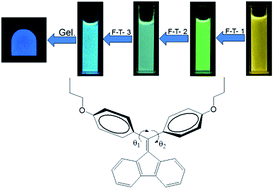Freezing-induced multi-colour emissions of AIE luminogen di(4-propoxyphenyl) dibenzofulvene†
Abstract
This work reports the freezing-induced emission change of di(4-propoxyphenyl) dibenzofulvene (DBF) molecules, which exhibit unusual aggregation-induced emission (AIE) and crystallization-induced emission enhancement (CIEE) effects. DBF powders in both amorphous (orange) and crystalline (yellow and green) states undergo rapid reversible shifts in their maximum emission wavelengths (λem) during the freezing–thawing (F–T) process. When the acetonitrile/water DBF dispersions emitting orange or yellow colours are F–T treated, their emissions change to green. Moreover, the DBF dispersions containing poly(N-vinylpyrrolidone) (PVP) and acrylamide (AAm) undergo gradual and more significant blue-shift in λem with F–T cycles, and further blue-shifts in λem are found when F–T treated dispersions are gelated or just kept for some time. The emission change of the DBF dispersions with the F–T process and the after-treatment is confirmed to be due to the change of their aggregation morphologies. DBF dispersions and hydrogels with different emission colours are obtained, and the luminescent hydrogels exhibit excellent mechanical properties. This study reveals a new freezing-induced emission change of AIE substances and provides a simple method for preparing hydrogels emitting different colours by using one luminogen.


 Please wait while we load your content...
Please wait while we load your content...